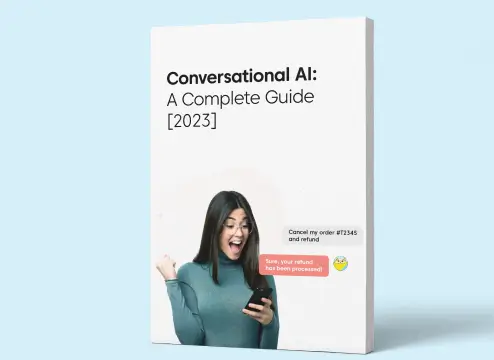Did you know?
Venture capital firms have invested more than $1.7 billion in generative AI solutions over the last three years, with the most funding going to AI-enabled drug discovery and AI software coding.
From the latest research and advances in deep learning to practical generative AI examples and case studies of real-world applications, marketing, and media are already feeling the impacts of generative AI.
Gartner expects:
- By 2025, 30% of outbound marketing messages from large organizations will be synthetically generated, up from less than 2% in 2022.
- By 2030, a major blockbuster film will be released with 90% of the film generated by AI (from text to video), from 0% of such in 2022.
AI can not only boost our analytic and decision-making abilities but also heighten creativity.
— Harvard Business Review
Generative AI applications
Generative AI has a wide range of potential applications, and its ability to generate new, realistic data has the potential to revolutionize many industries.
1. Generative AI in NLP
Generative AI for Conversational AI is one of the most exciting and rapidly developing areas of artificial intelligence. As AI continues to evolve, many generative AI companies have come ahead to harness the ability of generating human-like responses in a conversational setting. It has the potential to revolutionize the way we interact with machines, creating more natural and human-like conversations that are tailored to our individual needs and preferences.
Here are a few ways that generative AI can be used in automation platforms:
- NLP training data generation: Generative AI is used to generate new, realistic data that can be utilized to train machine learning models. This is particularly useful in situations where there is limited data available or when the existing data is biased or incomplete.
- Test data generation: Generate test data for software testing to save time and effort by eliminating the need for manually creating the test data. This is useful because it allows developers to test their software on a wide range of scenarios, which can help to uncover bugs and other issues.
- Process automation: Automate repetitive tasks such as data entry, document classification, and image recognition. This can help to improve efficiency and reduce errors.
- Decision support: Generate simulations and scenarios that can be used to support decision-making processes. For example, generative AI can be used to generate different production scenarios that can be used to optimize manufacturing processes.
2. Generative AI in conversation design
Currently, the problem with designing a conversational interface is that it’s important to take a bottom-up approach. This means designers need to envision what and how conversations will take place between users and chatbots and then design the conversation and its flow. This can be challenging as designers need to predict users’ inputs well ahead of time.
Generative AI can help in such cases while generating responses that enable designers to cover most of the user’s response as part of the conversation designs. Additionally, these models can be fine-tuned on specific datasets to improve their performance in a given domain.
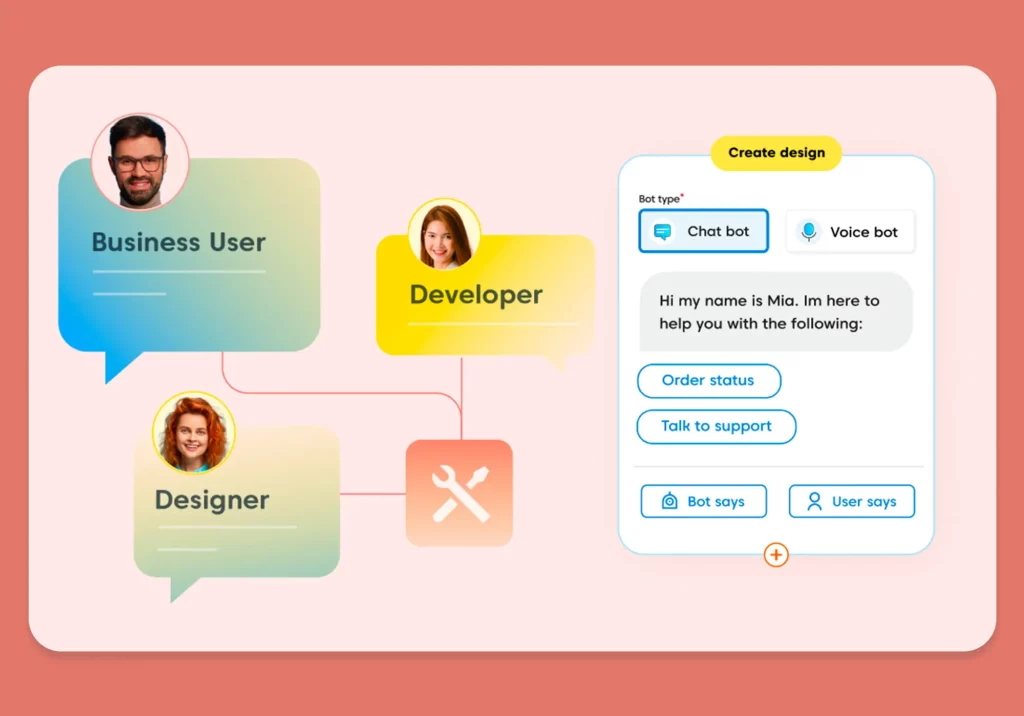
Generative AI is becoming increasingly popular in the field of conversational design. From using traditional chatbots that rely on predefined scripts to respond to users, generative AI has created a revolution in getting trained on large datasets of human conversations to learn how to generate natural-sounding responses.
3. Generative AI in creating a knowledge base
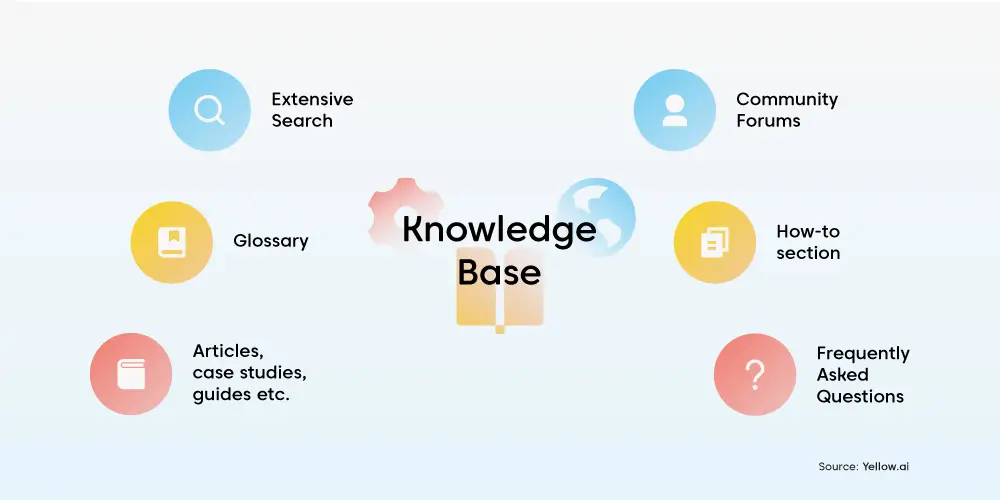
Generative AI can be very helpful in creating a knowledge base by generating new content, summarizing existing content, categorizing content, and generating questions and answers.
- Content generation: Generative AI can be used to generate new text content, such as articles, blog posts, and product descriptions, that can be used to populate the knowledge base. This can help to ensure that the knowledge base is comprehensive and up-to-date.
- Summarization: Summarize existing text content, such as customer feedback and reviews, into shorter, more easily digestible formats. This can help to improve the overall accessibility and usefulness of the knowledge base.
- Categorization: Categorize content based on topics or keywords, which can make it easier for users to find the information they need. This can help to improve the overall usability of the knowledge base.
- Question and answer generation: Generate questions and answers based on existing content in the knowledge base. This can help to ensure that the knowledge base is addressing the most common customer inquiries and concerns.
4. Generative AI to improve agent productivity
Generative AI improves agent productivity by automating routine tasks, providing automated responses to common inquiries, generating insights, and supporting sales activities. By using generative AI to support agents, organizations can improve overall customer experiences and increase efficiency. Few generative applications in customer service and support industry are –
- Chatbots and virtual assistants: Create chatbots and virtual assistants that can handle routine tasks and inquiries, freeing up agents to focus on more complex tasks that require human intervention.
- Customer insights: Analyze customer data and generate insights that can be used to improve customer experiences. This can help agents to better understand customer needs and preferences, which can improve the quality of customer interactions.
- Sales support: Generate personalized product recommendations and offers for customers, which can help to increase sales and improve customer satisfaction.
5. Generative AI in omnichannel marketing
Generative AI aids omnichannel marketing by generating personalized content and product recommendations that can be delivered across multiple channels.
- Personalized content: Generative AI can be used to create product descriptions, email subject lines, and social media posts, which can be tailored to individual customers based on their preferences and behavior. This can help to improve engagement and conversions across multiple channels.
- Product recommendations: Offer personalized product recommendations for customers based on their purchase history and behavior. These recommendations can be delivered across multiple channels, such as email, social media, and website pop-ups, to encourage customers to make additional purchases.
6. Generative AI in customer lifecycle management
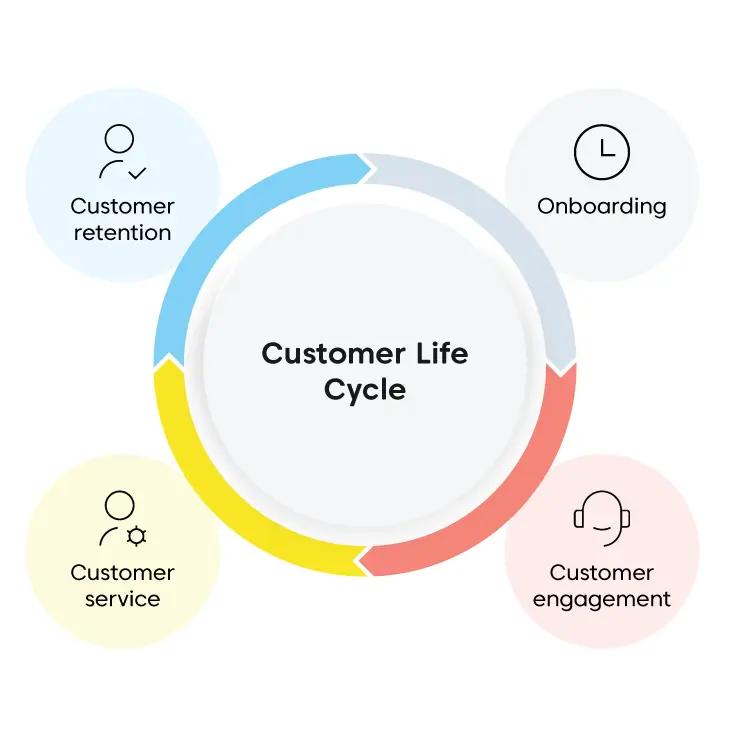
By using generative AI to automate customer lifecycle management, organizations can improve customer retention, increase engagement, and drive sales.
- Onboarding: Generative AI can be used to create personalized onboarding experiences for new customers by generating welcome emails, personalized tutorials, and product recommendations based on their preferences and behavior.
- Customer engagement: Offer personalized content, such as product recommendations and blog articles, that can be delivered to customers at various stages of the customer lifecycle. This can help to improve engagement and increase the likelihood of repeat purchases.
- Customer service and support: Create chatbots and virtual assistants that can handle routine customer service inquiries, such as order status and product returns, freeing up agents to focus on more complex issues.
- Customer retention: Deliver personalized content, such as loyalty program rewards and targeted promotions, that can help to retain customers and encourage repeat purchases.
7. Generative AI in Content Management
- Content generation: Generative AI can be used to generate generate new articles, blog posts, and product descriptions, based on specific keywords or topics. This can help to ensure that the content is comprehensive and up-to-date.
- Content optimization: Optimize existing content by analyzing keywords, structure, and tone, and generating suggestions for improvement. This can help to improve the quality and relevance of the content.
- Translation: Translate content into multiple languages, which can help to reach a wider audience and improve accessibility.
- Metadata generation: Generate metadata, such as keywords, tags, and descriptions, which can help to improve search engine optimization (SEO) and make the content more discoverable.
- Content categorization and tagging: Generative AI can be used to categorize and tag content based on topics or keywords, which can make it easier to find and organize content within a content management system.
8. Generative AI in intelligent segmentation
- Customer behavior analysis: Analyze customer behavior, such as purchase history, website visits, and social media interactions, to identify patterns and generate insights that can be used to segment customers based on their behavior.
- Persona creation: Generative AI can be used to generate customer personas based on demographic, psychographic, and behavioral data. These personas can be used to segment customers based on their needs and preferences.
- Customized marketing campaigns: Generative AI can be used to fetch insights that can be used to create customized marketing campaigns for different customer segments. For example, generative AI can analyze customer data and generate insights that can be used to create targeted email campaigns, social media campaigns, and other marketing initiatives.
- Predictive modeling: Build predictive models that can be used to segment customers based on their likelihood to purchase, churn, or engage with a brand. These predictive models can be used to create targeted marketing campaigns and other initiatives.
Potential pitfalls of generative AI
While generative AI has many benefits, there are also concerns that businesses and individuals should be aware of. These include:
- Misinformation: Generative AI can be used to generate generate fake or misleading content, such as deep fakes, which can be used to spread misinformation or propaganda.
- Data privacy: Businesses require large amounts of data to be trained, and this data can include personal information. Businesses and individuals need to ensure that they are collecting and using data ethically and in compliance with data privacy regulations.
- Security: Generative AI can be vulnerable to cyber-attacks and other security threats, which can result in the theft or misuse of sensitive data.
- Ethical concerns: The use of generative AI can raise ethical concerns around the responsibility of businesses and individuals in ensuring that it is used ethically and in a way that aligns with social and cultural values.
Businesses and individuals need to be aware of these concerns and take appropriate steps to address them, such as ensuring that generative AI models are trained on unbiased data, using it responsibly and ethically, and implementing strong security measures to protect sensitive data.
Is generative AI here to replace humans?
While generative AI can create new content, including text, images, and even music, it can be challenging to distinguish it from the content created by humans. However, it is important to note that AI is a tool created by humans and operates based on the algorithms and data it has been trained on.
While generative AI has made significant advances in recent years, it is not capable of replacing humans entirely. AI lacks the creativity, intuition, and empathy that humans possess, and it cannot replicate the full range of human experiences and emotions.
Furthermore, generative AI is only as good as the data and algorithms it has been trained on. If the data is biased or the algorithms are flawed, the generated content may reflect those biases and flaws.
Instead of seeing AI as a replacement for humans, it is more helpful to view it as a tool that can assist humans in various tasks. By working together with AI, humans can leverage their strengths to enhance their abilities and accomplish tasks more efficiently and effectively.
The Future of Business with Generative AI powered by Yellow.ai
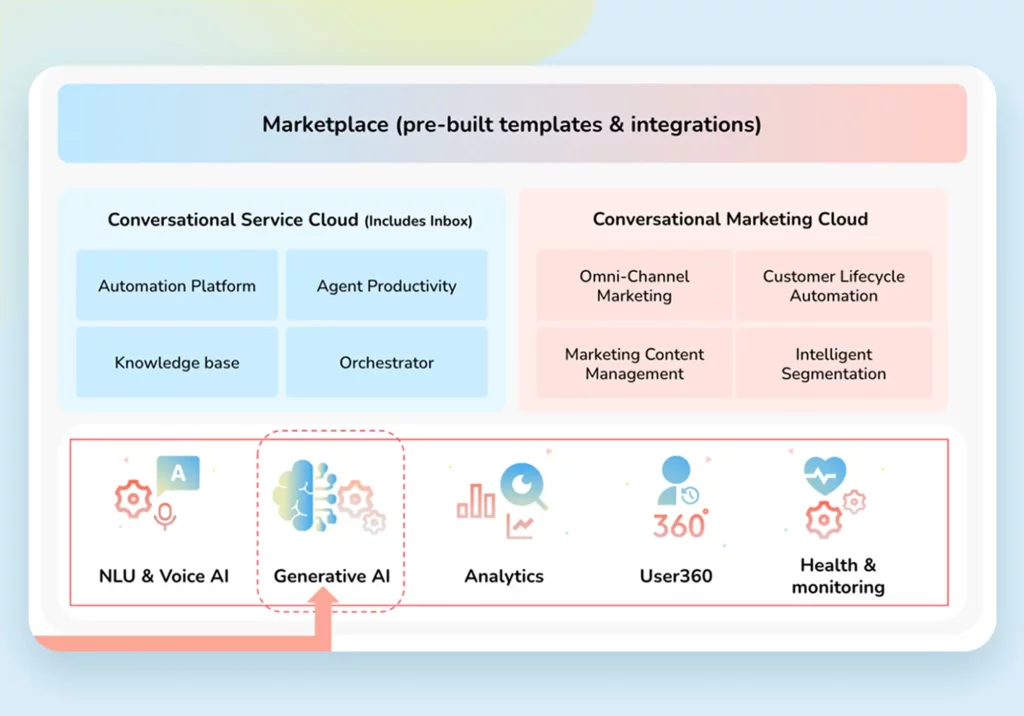
At Yellow.ai, we use a combination of generative AI technology and our Dynamic Automation Platform (DAP ), which holds all the data, behavior, and experiences collected by our Dynamic AI agents. Using this, we aim to deliver improved business results across the breadth of use cases including automation, agent support, and marketing conversations. Businesses will get benefits such as –
1. Reduced costs and improved efficiency in bot building
According to a survey conducted by Deloitte, set-up challenges, including training data and maintenance, were among the top reasons for not implementing chatbots in enterprises. While enterprises have many documents with product and support information, barely 25% of that is captured in manually configured QnA bots.
The solution offered by Yellow.ai:
Generative AI in Bot building
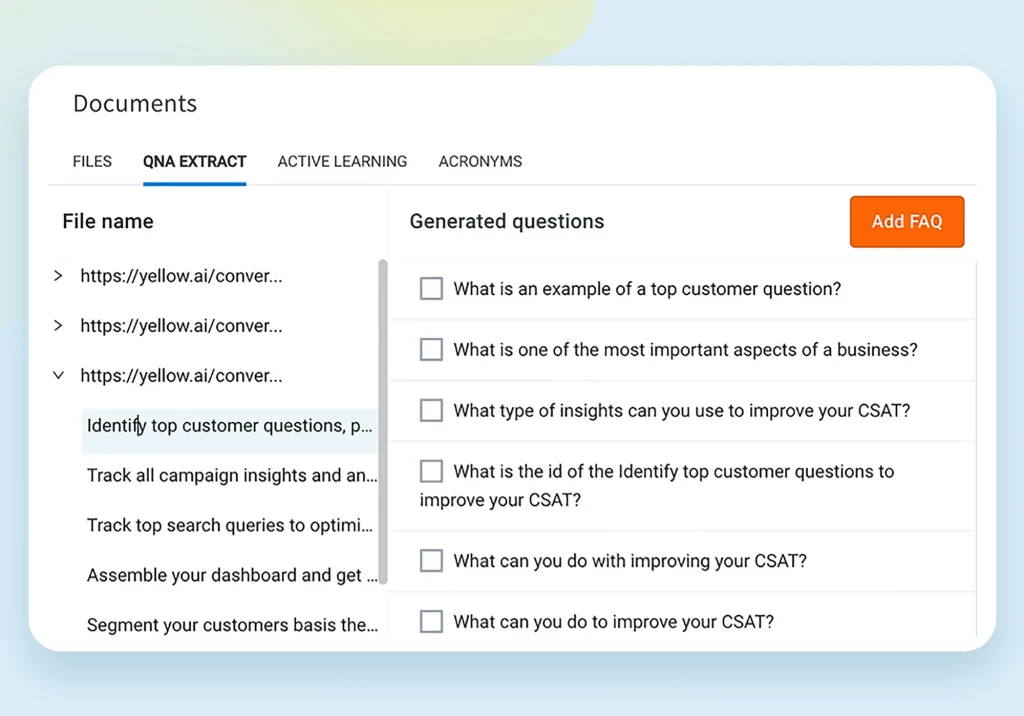
- Generative AI in Yellow.ai will help the chatbot developers by suggesting the best next step in conversational flow automation so that all the scenarios are covered and maximum automation is achieved. Also, it anticipates how users might respond to the chatbot and then design user journeys based on set goals.
- With the help of generative AI, testing data is generated automatically so the user avoids having to write it one by one and will be able to bulk test the generated utterances. Auto-generating test data helps in reducing the testing time by 50%.
- The main aim of Document Cognition, Yellow.ai’s knowledge discovery solution, is to help users get instant and accurate answers to their queries from unstructured formats (data and images) using NLP and Machine Comprehension. Yellow.ai Document Cognition and keywords also search content based on the subject and meaning. Let’s say – the keyword is “credit limit” and the user asks “What is the highest amount that can be sanctioned?” Document Cognition can respond to the user with the right answer to this contextually related question.
Benefits:
- Faster time to market
- Go live within minutes by automating FAQs from documents/URL
- Better coverage of FAQs
- Train your bot on thousands of FAQs from multiple sources
- Improved accuracy
- Achieve more than 97% intent accuracy from day one
2. Enhanced customer engagement
Successful customer engagement requires a customer-centric approach, effective communication, and a willingness to adapt to changing customer needs and preferences.
Customers today expect a seamless and consistent experience with a personal touch, and any deviation from this can be a turn-off. Many enterprises struggle to customize their interactions with customers, which can result in disengagement or even frustration.
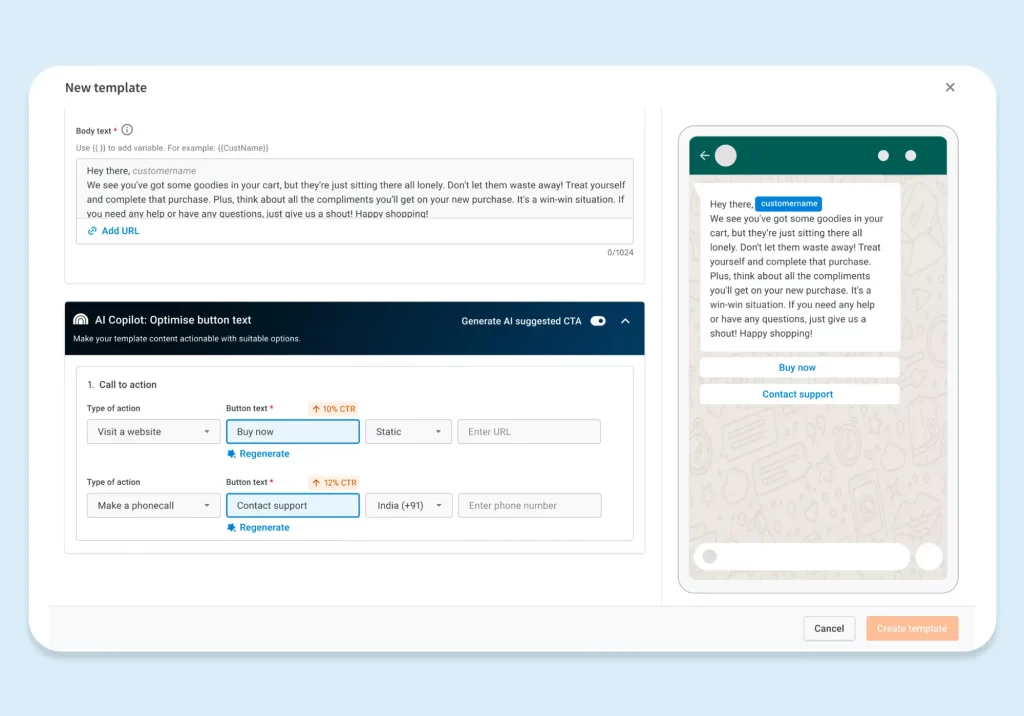
The solution offered by Yellow.ai:
Generative AI in marketing campaigns
- Organizations can improve engagement rates & reduce drop-offs along a buyer’s journey by using contextual nudges across channels including web, text, social, voice, etc.
- Based on parameters such as audience type, user behavior and the campaign goal, the AI-powered template manager generates the most relevant content for a marketing campaign. Marketers can nurture leads, and interact with users via these conversations to understand their preferences and purchase intent.
Benefits:
- Improve lead generation by 20%
Generate high-quality leads with accurate targeting
- Increase customer engagement by 60%
Nudge users at the right time, on the right channel
- Improve CSAT by 40%
Get contextual history across different channels and communicate effectively3.
3. Improving agent productivity
The quality of customer service is a major factor in determining CSAT scores. Enterprises that provide high-quality customer service, such as responsive and friendly support, are more likely to receive positive feedback from customers. However, businesses of all sizes face common problems, such as:
- 30% of agents spend considerable time crafting repetitive responses to communicate to customers rather than looking for solutions to help them.
- More than a fifth of the costs of running a contact center are incurred in coaching agents and ensuring the quality of support.
- Contact centers grapple with high attrition rates. Managing support quality becomes a huge challenge given the agent turnover.
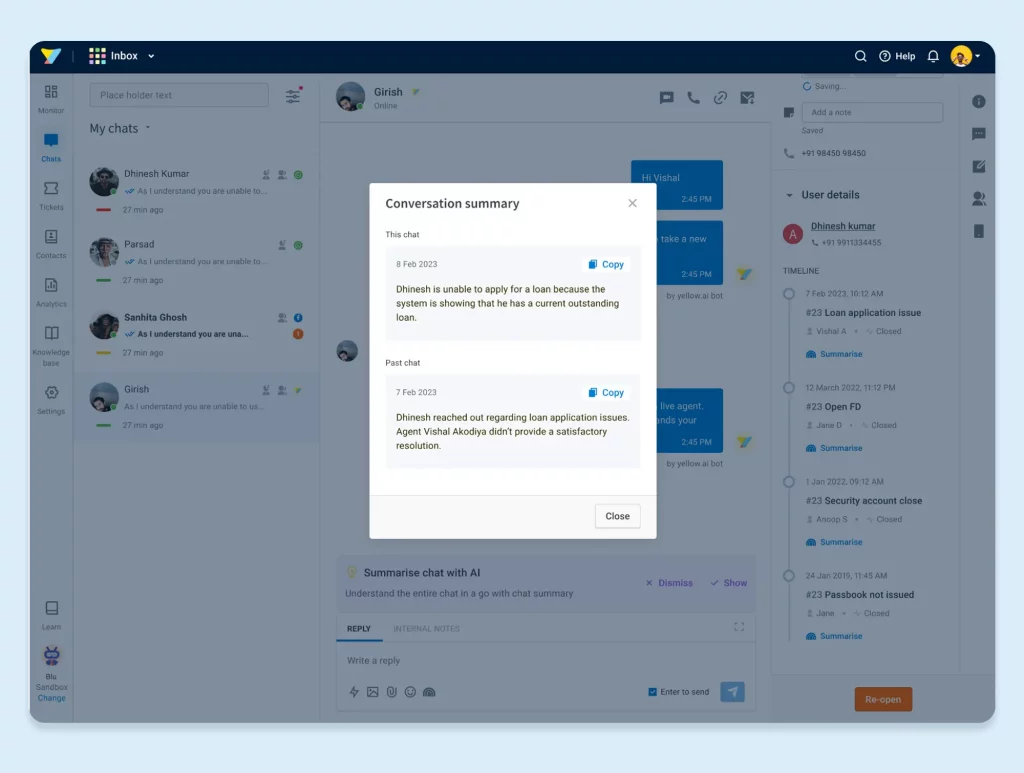
The solution offered by Yellow.ai:
Generative AI in customer service
- Agents can get suggested replies to customers’ queries with the help of Generative AI in Yellow. This will help agents to understand customer issues faster since they don’t have to read through current or past ticket transcripts. Also, agents can view the timeline of recent tickets and summaries of any specific ticket to provide quicker first response to customers and faster resolution, eventually leading to better CSAT.
- Based on agents’ activities, with the help of generative AI in Yellow, the platform creates coaching insights for agents that will help them improve their performance and productivity.
Benefits:
- Improved “First response time (FRT)” and “First contact resolution rate (FCR)”
- Improved agent productivity and CSAT
- Save cost and time spent on quality assurance controls and improve support quality
Generative AI For A Seamless Customer Experience
Generative AI can be used in many ways to enhance customer experience. From training your chatbots to interact with customers and providing them with quick and accurate responses to their queries to helping your customers with various tasks, such as booking appointments, ordering products, or finding information — generative AI can help businesses provide a more personalized and efficient customer experience, leading to increased customer satisfaction and loyalty.
Using Yellow.ai’s Generative AI platform, create chatbots and virtual assistants that can handle complex conversations. By using our powerful platform, you can automate customer support, lead generation, and other business processes to improve efficiency and provide a better customer experience.







